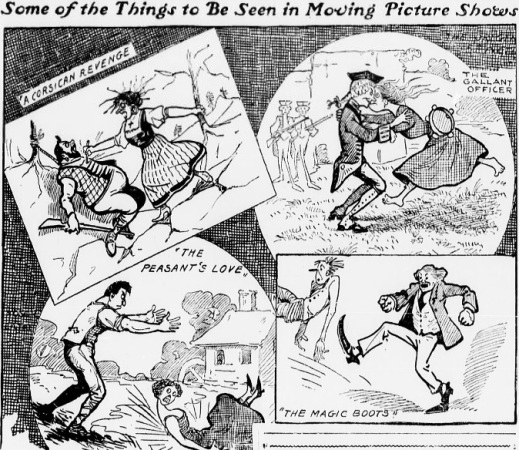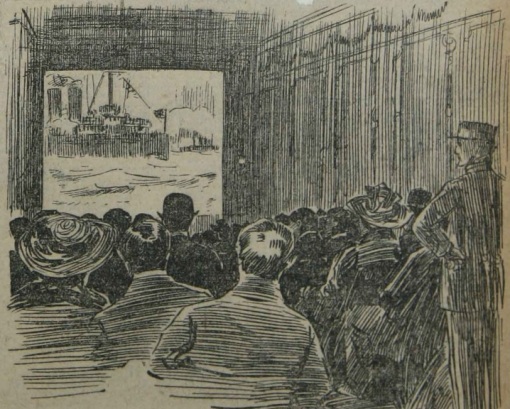Source: ‘Cinematographs – Truth and Fiction’, The Times [London], 9 April 1913, p. 11
Text: At the present moment the popularity of picture palaces and the reason for it are directing a good deal of attention to the state of the public mind. But these sudden crazes are not new: 30 years ago it was croquet, 15 years ago it was cycling, ten years ago it was roller-skating. It seems that from time to time, like a person lying long in bed, we turn over and try a new position. Nevertheless, whenever it happens, the more thoughtful part of the race becomes alarmed, collects statistics, and wonders what this development, which it chooses to call backsliding, is caused by. We have lately been told that picture palaces are preventing us from going to church, from going to the theatre, from going to public houses, and from reading novels. On the other hand, we may find encouragement in the fact that the number of people who use works of reference is increasing.
One need not be thoughtful, or specially anxious about the future of the race, or a great believer in the value of statistics, and yet one may wonder as one walks down the Strand or Oxford Street or Tottenham Court Road why these excessively brilliant doorways which star the pavement at such short distances apart prove so irresistibly attractive. It is true that the management often provide tea for nothing, and the carpets are very thick, and the attendants as finely grown as Royal footmen, and all these things are good; but without such attractions, when the door is unlit and down a back street, and the seats are hard and the attendants meagre and peremptory, we go – we pay our sixpence, we sit there until the first picture begins to come over again, and directly the programme is changed, which is not as often as it should be, we pay our sixpence and go once more.
But what is the reason of it? Why do we invariably find the hall full of men and women, old, elderly and young, paying their sixpences, listening intently, going away and coming again? No doubt we are all feeling much the same thing, and we are driven to drop in by some such experience as this.
After trudging for an hour and a half in and out of tubes, shops, omnibuses, hard pavement for the feet, grey sky between the houses, wind blown, with uncharitable people to confront, there comes a moment when it is no longer to be borne. Whoever you are, whatever your tastes, you stop at some street corner and declare that you must immediately escape. The only question is whether it shall be to a church or to a picture gallery or to a publichouse [sic] or to a library. Each of these offers some kind of relief from the stony superficiality, the inhospitality, the impersonality of the street. Each offers some kind of resting room where you may recollect your human soul. At the same time each demands a certain effort, a certain chafing and stamping if one may so call it, before one is comfortably aglow. It is now that the lighted doorway presents itself. The picture palace offers immediate escape with the least possible expenditure of energy. You have only to lean back in a well-wadded chair, and you are floated upon some ambling dance tune down southern streets, or to the dusty jungle where the lion crouches, or to the centre of some public pageant, where merely to trace the expressions of the faces is to be in at the making of history. The street is only a few yards away, and five minutes ago you were cold and wind blown like the rest; but now that is nothing, or is a dream. You are now in the position most comfortable to man – sitting at ease, observing, speculating, ruminating, imagining, with hardly any trouble to yourself. All the work seems to be done for you. The marvellous way in which an illusion, strong enough to defeat circumstances, is created at once, without any effort of imagination, must be attributed chiefly to the fact that the picture moves. You never have time to be bored by one picture before it changes, becomes another picture, becomes not only a picture but a story, something which has a separate life of its own. Meanwhile you are being worked upon, as indifferent music that goes straight to the obvious emotion does work upon one, and made to feel without willing it rather more than is reasonable.
But this is only part of the secret, for the stream of traffic outside has no such power to please. A great part of the enchantment must lie in the fact that the most trivial scene – let us say a meet of coaches in Hyde Park – when cut off from its surroundings becomes for some queer reason significant, even emotional, as it seldom does in reality. Looking up from an arm-chair in a darkened room you see as you have never seen before. The horses and the women and the trees appear on the sheet as if they had nothing to do with the future or with the past, as if the whips would never descend, or the grooms swing up behind, or the horses trot off down the road to Richmond. Let alone the strange way in which isolating something from its context heightens the meaning, there is the sheer excitement and curiosity of the sights themselves. For the first time we see wild beasts creeping down to the pools to drink, or ice-fields grinding each other in the Polar sea. We might almost say that for the first time we see flowers unfolding and waves breaking on the beach.
Indeed the only grudge we have against the management of picture palaces is that they will go to any amount of trouble and expense in dramatizing romantic stories which take place, we believe, in cardboard castles in the outskirts of Paris, when the streets are full of pictures at once more comic, more tragic, and possessed of the incomparable recommendation that they are true. Suppose that, instead of inventing an improbable love story complicated by a couple of fierce brown bears in the Rocky Mountains, which has to be conveyed by trained actors carefully made up and craggy steeps that fail to convince, we had simply 12 o’clock yesterday in London, Paris, Moscow, Madrid, New York, Rome. The effect would be far more striking, and we must suppose a tenth part as expensive. Those half-dozen pictures of real people going about their businesses in real streets on different sides of the world, with all the little oddities and incidents that one would delight in detecting, would set up an image of the earth and mankind that would surpass all the lovers and all the bears in America.
The versions of famous novels and imaginary adventures which fill three-fourths of the programme appeal, of course, to our love of story-telling, and if they tend to be a little monotonous they have the advantage that moving pictures are simpler, quicker, more direct than the best printed prose can ever hope to be. Whether in this extraordinary greed of the eye we are to see reason for alarm or not, we do not know. We are inclined to expect that the eye in England has been rather cruelly starved. At the present moment, at any rate, it will take anything you choose to give it, as long as it moves quickly and is exactly like life. We are ready to look at places, people, animals, plants, waves, things that never happened, things that were written about, things that could no possibly happen anywhere. What the brain does with all this material it is difficult to say. Judging from personal experience, we should be inclined to believe that it remains quiescent during the greater part of the time, amused but not stimulated; that there are scattered moments of pure revelation; and, that, for the rest, a marvellous confusion reigns, a welter of music, of facts, of fiction, of forms. It is not life, it is not art, it is not music, it is not literature. Whether, all the same, we are fumbling towards some new form of art which is to have movement and shape, to be like life and yet to be selected and arranged as a work of art, who can say? In the meantime we have a fury for seeing and remain happy, greedy and terribly indiscriminate.
Comment: I write about the significance of this fascinating, anonymous article in ‘A Fury for Seeing: Cinema, Audience and Leisure in London in 1913′, Early Popular Visual Culture, vol. 6 no. 3 (November 2008) [available online through restricted academic services only]

